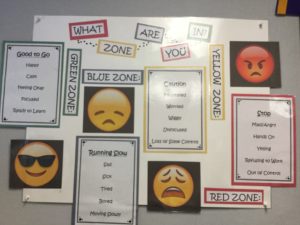REALITY CHECK: Sixty percent of adults believe that young people’s failure to learn moral values is a serious national problem. Over the past two decades, there’s been a decline in children’s moral character, and 72 percent of Americans say moral values are “getting worse” a large majority of college students say “cheating is necessary to get ahead,” and 70 percent admit to cheating. Not surprisingly, cheating is also on an upswing, and the most typical kind of moral reasoning among recent undergraduates is focused on personal interests, not on what’s right for others. [From UnSelfie]
* * * * * * * *
The teacher read Alfred’s misbehavior report and shook her head. It was his third playground citation this week and like the others it was about his derogatory comments. “Alfred you can’t keep saying negative things to people,” she explained. “You’ve got to start acting more respectfully.” “I’ll try,” he sadly responded. “It’s just that I don’t know what respectfully means.”
Teachers everywhere are voicing a concern: Far too many of their students do not know the meaning of critical character traits. As a result, a growing number of students are failing in a core subject needed for successful living: solid character. Psychologists tell us one way students learn character traits is by watching others do things right. Recall just a few incidents children have recently seen on national television: from professional baseball players spitting in umpire’s faces, boxers, a champion boxer biting a chunk off his opponent’s ear, Super Bowl Sunday events now requiring airing delays because who knows what an entertainer will reveal to the kiddies. Then there are the litany of national scandals involving politicians to priests to corporate officials to even teachers. Or what about the recent Presidential Campaign? Now ask yourself, “To whom are your students looking to learn sound character traits?” the answer is troubling.
The breakdown of appropriate role models is certainly not the only reason for the decline in character development. Dr. Thomas Lickona, author of Character Matters, cites an increase in ten troubling youth trends in our society that point to an overall moral decline: violence and vandalism, stealing, cheating, disrespect for authority, peer cruelty, bigotry, bad language, sexual precocity and abuse, increasing self-centeredness and declining civic responsibility, and self-destruction. It’s yet another reason why so many of today’s students lack solid character.
School: The Last Beacon of Hope
The fact is that school may very well be the last beacon of hope for many students. Where else will they have a chance to understand the value of a trait called “responsibility” or “caring” or “respect” or “cooperation”? Where else will they have the opportunity to watch someone model these traits appropriately? Where else but from a caring, committed teacher will many of today’s students have a chance to learn the traits of solid character?
So how do we help our students develop strong character? The answer is found in this premise: Character traits are learned; therefore we can teach them. It means that educators have tremendous power because they can teach students critical character traits. And how to build students’ character involves a few crucial steps. Keep in mind that the goal is for your students to internalize the character trait so they will adopt it for life.
First Steps to Teaching Any Character Trait
No matter what character trait you choose to enhance—perseverance, determination, empathy, responsibility, respect, caring, or any other—there are five minimum steps to teaching it. The steps can easily be integrated into your lesson plans and woven into your school day. Each step is equally important in ensuring that your students develop stronger character. Here are the five teaching steps.
Step 1. Accentuate a Character Trait or Virtue

Portrait of a Canterbury Graduate from Canterbury School of Florida
The first step to teaching any new character trait is to decide which traits matter most. Which traits do you feel are most pertinent to your students? Or, when your students graduate from your school which character traits will help your students succeed? Canterbury School in Florida created their “Portrait of a Canterbury Graduate” and display it in their hallways and handbooks. That portrait guides their character education program.
Once you choose those traits, accentuate them to students. Many schools have found emphasizing a different character trait each month can be a successful, practical first step approach. When everyone at your site is reinforcing and modeling the same trait, students are more likely to learn the new character trait. As each new character trait is introduced, a student campaign committee can start a blitz creating banners, signs, and posters to hang up around the school convincing (or at least advertising) the rest of the students of the trait’s merit.
Over 400 character traits have been identified over time. So choose one trait to tune into so you can weave it into your lessons. A few character traits or virtues that schools typically address include:
Honesty. Trustworthiness. Compassion. Caring. Respect. Responsibility. Self-control. Charitableness. Citizenship. Cooperation. Courage. Courtesy. Dependability. Empathy. Fairness. Forgiveness. Friendship. Generosity. Gratitude. Honor. Initiative. Integrity. Joyfulness. Justness. Kindness. Loyalty. Moderation. Optimism. Peacefulness. Perseverance. Prudence. Reliability. Reverence. Self-discipline. Sensitivity. Sincerity. Tolerance. Understanding. Unselfishness. Grit. Self-regulation. Serenity. Tactfulness.Choose traits that you will help your students be successful in school and in life. Aim to strike a balance between virtue that nurture morality and heart (compassion, kindness, peacefulness, justice, tolerance, empathy) and virtues that cultivate performance (like perseverance, self-control, grit). Make sure those traits are also part of your school Mission Statement and classroom rules.
Here are four of the simplest ways to accentuate a character trait:
Character posters. Ask students to make posters about the trait. Be sure to hang them everywhere and anywhere for at least a month: “Responsibility: IT means I’m doing what is right to myself and others and I can be counted on.”

Renbrook School in West Hartford’s Upstander Assembly
Character assembly. Many sites introduce the trait at a school-wide assembly. The staff may describe the value of the trait and perhaps present a short skit about it. If you do the “assembly strategy” make the presentation meaningful. Involve your students!
The photo on the right is one I took at the assembly at Renbrook School. Their monthly trait was “Courage.” Each student took a pledge to be an “Upstander” (speaking up and helping peers) and wrote it on a post it. High school students in Taipei stood on stage to convince their peers to sign an Honor Code for the theme of Honesty. Elementary students in Minneapolis role played ways to be Upstanders for the theme of Courage.
Screen savers. Each day a staff or student writes a brief sentence describing the trait’s benefits on the central screen saver. Anytime anyone in the school uses the computer, the first thing seen is the screen-saver message accentuating the trait: “It’s perseverance month. Remember to work your hardest and not give up!” Students on the US Army Base in Vicenza, Italy created fabulous PSA announcements regarding their monthly themes and displayed them over large video screens in the hallways.
PA announcements. Many teachers (and schools!) use the beginning of each day to describe over the loud speaker ways students can demonstrated the selected trait. Names of students “caught demonstrating the trait” can also be announced.
Step 2. Teach the Value and Meaning of the Trait
The second step to teaching a character trait is to convey to students exactly what the trait means and why it is important to learn. Explain the trait to your students within their realm of experiences, never assuming they’ve been exposed to the trait. Many have not. Here are a few ways to define new traits to students:

St. Anne’s School In Annapolis uses literature to teach Empathy
Character literature. Choose an appropriate selection that embodies the trait and as you read it, ask: “How did the characters demonstrate the character trait? How did the other characters feel when the character acted (name the trait).” Examples might be Charlotte’s Web (for compassion), The Little Engine That Could (for perseverance) or Courage (for courage – what else? by Bernard Weber). Or align your assigned novels with the character virtue (like To Kill A Mockingbird, Red Badge of Courage, Things Fall Apart, The Diary of a Young Girl). The photo is from St. Anne’s School in Annapolis. Their monthly theme is empathy: their front bulletin board displays the empathy-building books that will be used to help teach the virtue.
New articles. Ask students to collect current news articles of real people demonstrating the trait. You might begin each day with a brief review of a real event in which the trait was displayed to confirm the trait’s value. And then tacking those articles to a bulletin board so students are exposed to real heroes in the world who actually do emulate the traits. (I’ve seen many bulletin boards created by high school coaches that display good sportsmanship to students).
Label traits. Whenever you see or hear a student displaying the targeted trait, take a moment to point out specifically what the student did that demonstrated the trait. “Alex, that was respectful because you waited until I was finished talking before you spoke.”
Share your belief. Students need to hear why you feel the trait is important. If you are targeting respect, you might tell students how adamant you feel about not talking negatively about yourself or others.
Student reporters. Ask students to look for demonstrations of the trait by others at the school. Their job is to report to the class who demonstrated the trait, what the student did, and the effect the students’ actins had on other individuals.
Step 3. Teach What the Trait Looks and Sounds Like

Make Character Education Age Appropriate!
There is no perfect way to teach the trait, but research on teaching new skills says telling students how to do the behavior is not nearly as important as showing them the behavior. You can make a significant difference by modeling the trait and making your character education lessons as concrete as possible. Here are three ways.
Trait role plays. Some teachers find it helpful to use another student or colleague to role-play what the trait looks like to their students. It’s a simple way to show students exactly what the trait looks and sounds like.
Character skits. Students can create quick skits about a character trait and perform it at either a school-wide assembly or in each classroom to show others students the value of the trait and as well as what the trait looks and sounds like.
Trait photographs. Photograph students actually demonstrating the character trait. Develop the picture, enlarge them on a copying machine and paste them on a chart so they are reminded of what the skills looks like.

Teach Character Traits as Verbs Not Nouns!
Character habits. Do you already have a Social-Emotional Learning program? Are you using PBIS? Then pull a skill and align it with the trait. Let’s get character education off of a poster and into the hearts of students. The way to do so is by teaching character as a VERB, not a noun. The poster on the right is a habit for teaching Self Control from my book, UnSelfie. Many schools have adopted it as a monthly skill. A school in Brooklyn Park turned it into a refrigerator magnet for each student to take home and share with their parents. Every classroom has a large poster of the skill. Every student has a miniature version on their desk. And all students practice the skill at the beginning and end of each school day for one minute. Students are learning self-regulation!
Character must be taught as a habit or skill. For instance:
Courage: How to be an Upstander; Respect: How to use I-Messages; Kindness: Any courtesy skill; Justice or Fairness: How to do Conflict Resolution or Restorative Justice; Self-Control: Any anger management or calm down strategy.
Step 4. Provide Opportunities to Practice the Trait

Character Education Is School-Wide! (This is a Michigan high school).
Generally, students must be provided with frequent opportunities to practice the new behaviors. Learning theory tell us it generally takes 21 days of practice before a new behavior is acquired. This is an important rule to keep in mind as you try these activities with your students. Here are three ways to help students review their character progress:
Character videotapes. Students can see their progress by videotaping each other demonstrating the trait. The tape is played and analyzed for all to see. Send a flash drive home so students can also teach their parents the same lesson!
Write reflection logs. Students can keep an ongoing log of their trait progress by writing each day what one thing they did that day to demonstrate the trait. Better yet, the first minute of every class day students can be asked to open up their logs and write the one thing they will work on to be “the best they can be.” The end of the day, they refer back to their logs and track their success. Ideally, students should work on the same skill or habit for 21 days to maximize success.
Assign character homework. Ask students to practice the skill at home and record their efforts and results in a notebook.
Step 5. Provide Effective Feedback
The final step to teaching any character trait is to reinforce to students appropriate or incorrect trait behavior as soon as convenient. Doing so helps clarify to the student: “You’re on the right track; keep it up,” or “Almost, but this is what to do instead.” Catching students doing a behavior wrong before it becomes a bad habit increases the student’s chances of acquiring more positive character traits. Here are a few reminders about giving effective feedback:
Use constructive criticism. If the student’s behavior was correct, immediately tell him: “This is what you did right.” If the behavior was wrong, tell him what to do to make it right: “What you did was not right, but this is what you can do next time.”
Do on-the-spot correction. Students benefit from immediate behavior correction.
Catch positive behaviors. Look for opportunities to “Catch them doing the trait right.” When you reinforce character traits done correctly, students are more likely to repeat the behavior.
Educators Can Make a Difference
With the growing number of today’s students lacking solid character development, it is imperative that schools incorporate ongoing character education. Keep in the mind, the best character lessons are ones that blend naturally into your existing plans. There are endless ways to use literature, videos, music, quotations, news articles, and historical figures that embody the themes of strong character.
Perhaps the simplest way to enhance your students’ character development is to accentuate a character trait each month. Doing so optimizes students’ chances of development solid character they’ll use not only now but for the rest of their lives. Above all, never forget your own impact on your students’ character development. You do make a difference!
Dr. Michele Borba, Parenting Expert
 I am an educational psychologist, parenting expert, TODAY show contributor and author of 22 books including The Big Book of Parenting Solutions: 101 Answers to Your Everyday Challenges and Wildest Worries.
I am an educational psychologist, parenting expert, TODAY show contributor and author of 22 books including The Big Book of Parenting Solutions: 101 Answers to Your Everyday Challenges and Wildest Worries.
You can also refer to my blog, Dr. Borba’s Reality Check for ongoing parenting solutions and late-breaking news and research about child development.
My new book, UNSELFIE: Why Empathetic Kids Succeed in Our All-About-Me World is now in print June 2016. My goal is to create a conversation that makes us rethink our view of success as exclusively grades, rank and score and includes traits of humanity! It’s time to include “empathy” in our parenting and teaching if we hope to prepare children to succeed and thrive in our global new world.

